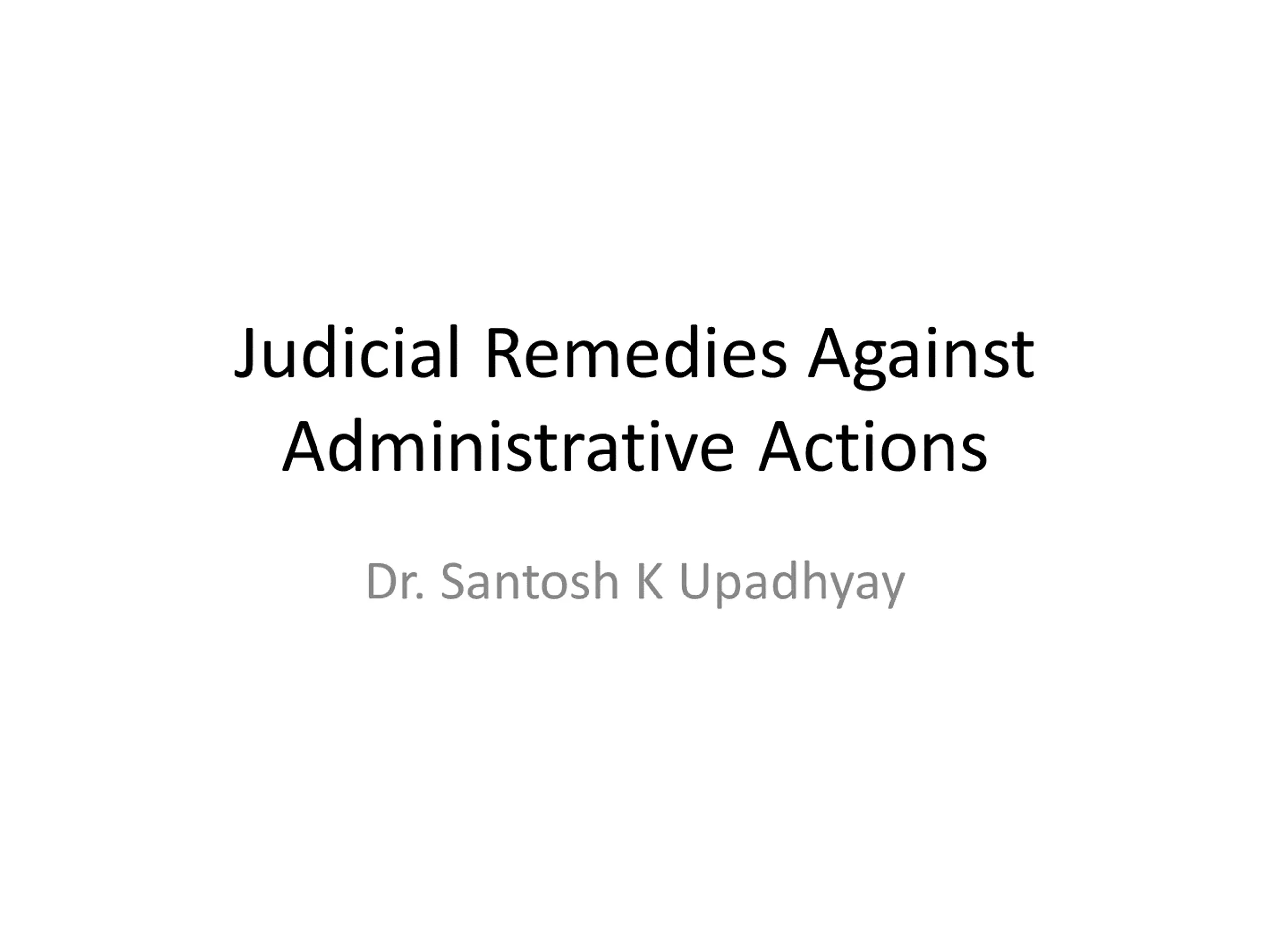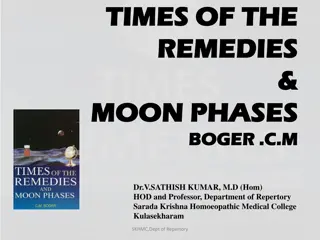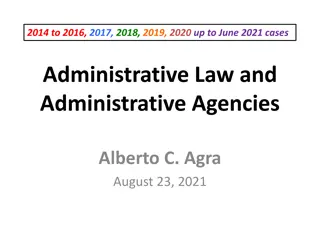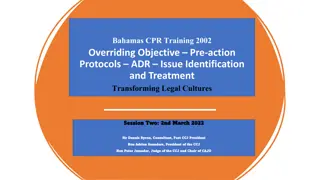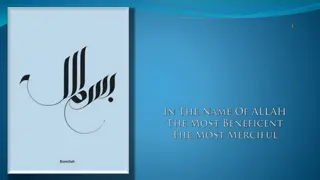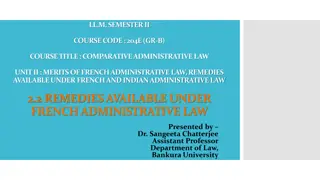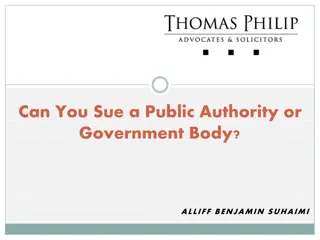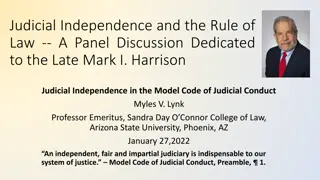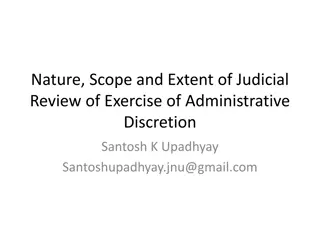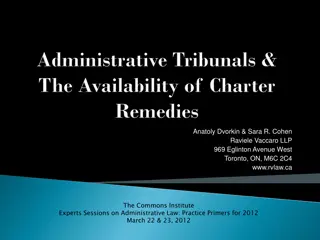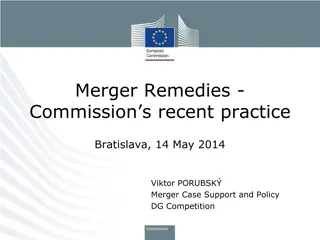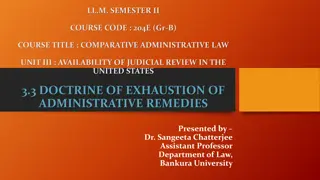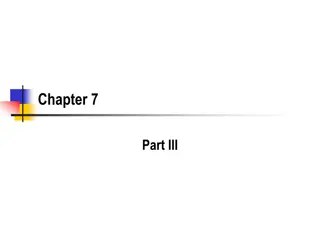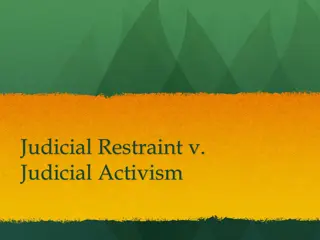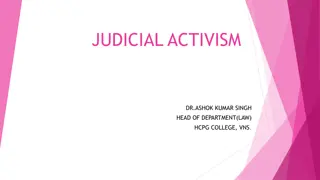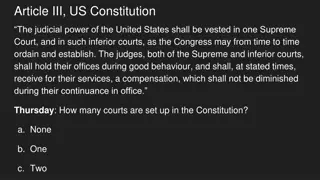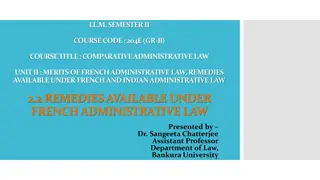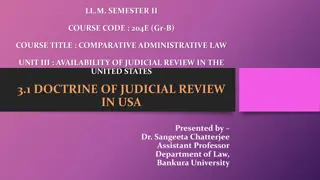Judicial Remedies Against Administrative Actions
The different judicial remedies available against administrative actions, including constitutional remedies and statutory remedies.
Download Presentation

Please find below an Image/Link to download the presentation.
The content on the website is provided AS IS for your information and personal use only. It may not be sold, licensed, or shared on other websites without obtaining consent from the author.If you encounter any issues during the download, it is possible that the publisher has removed the file from their server.
You are allowed to download the files provided on this website for personal or commercial use, subject to the condition that they are used lawfully. All files are the property of their respective owners.
The content on the website is provided AS IS for your information and personal use only. It may not be sold, licensed, or shared on other websites without obtaining consent from the author.
E N D
Presentation Transcript
Judicial Remedies Against Administrative Actions Dr. Santosh K Upadhyay
The Judicial remedies may be classified under two broader heads: (1) Constitutional Remedies (Article 32, 136,226 and 227) & Curative Petitions under article 142 (2) Statutory remedies sometimes statutes itself provide for judicial remedies against particular kinds of administrative actions. Any statutory remedy does not disturb the structure of constitutional remedies. Article 32 and 226 are Writ Jurisdiction of the Supreme Court and High Courts. Article 136 provides for special leave by Supreme Court and article 227 is Supervisory jurisdiction of High Courts.
Writ Jurisdictions (Article 32 and 226) (Introduction) Writ Jurisdiction of High Courts are wider than Writ Jurisdiction of the Supreme Court. Supreme issues writs for the enforcement of fundamental rights but High Courts can issue writs for enforcement of fundamental rights or for any other purposes. Non- Exhaustion of other generally are not the grounds for refusing to intervene in the cases of violation of fundamental rights. However, in cases other than fundamental rights, High Courts have evolved a principle that non-exhaustion of other alternative remedies may be the ground for denying a request for issuance of writs under article 226 of the Constitution. alternative remedies
There is no specific time limits for filing writ petitions but generally there should not be any unreasonable or inordinate delay without any justification. The Courts helps the vigilant and not the indolent.
Writ of Habeas Corpus Great constitutional privilege or security to civil liberty. It is a Latin term means you must have the body The writ affords an effective means of immediate release of a person held in unlawful custody of public or private authorities. Generally, it ascertains the legality of detention of individuals but SC in Sunil Batra (II) Case has widened its scope by giving relief against inhuman and cruel treatment meted out to prisoners in Jail. Court observed: the dynamic role of judicial remedies ..imparts to the habeas corpus writ a vitality and operational utility that makes the healing presence of the law live up to its reputation as bastion of liberty even within the secrecy of the hidden cell. The writ is issued to the authority which has the aggrieved person in its custody. There are many approaches as to the timings of checking the illegality of the detention. Whether at the time of detention, or at the time of filling of petition or at the time of hearing. Though there is no decisive pronouncement on these points. But it appears from Court s approach that the decisive time would be the time of filling of petition for Habeas Corpus. Court generally checks the validity of the detention order at the time of filling of petition of Habeas Corpus.
In Kanu Sanyal v District Magistrate (1973) Supreme Court held that it is not essential to produce the person alleged to be unlawfully detained before the Court at the time of hearing of his/her petition of Habeas Corpus or before that. Court concluded that habeas corpus is essentially a procedural writ. It deals with the machinery of justice and not with substantive laws. The object of the writ is to secure the release of a person who is illegally restrained of his liberty. It provides a speedy and effective remedy to a person under unlawful detention. The most important feature of the writ is its peremptoriness and the production of the body of the person alleged to be wrongfully detained is only subsidiary to this main purpose. The point is that body need not be produced but Court may issue writ and direct the authority to produce the body before it.
The Writ of Quo Warranto Means what is your authority. Its basic purpose is to judicially control the executive action of appointments to public offices under the relevant statutory provisions. The writ is issued to the holder of the public office to show to the Court under what authority he/she is holding the particular office. It is not issued to the appointing authority but to the appointed authority i.e. The alleged usurper of the public office. Malafide of the appointing authority is not a ground to issue the writ.
Writ of Mandamus Mandamus is a command issued by Court to an authority directing it to perform a public duty. It is employed to enforce a duty the performance of which is imperative discretionary with the authority concerned. Mandamus is generally issued to Public bodies but in certain circumstances it can also be issued to private bodies engaged in performing public functions. (Anadi Mukta Sadguru Shree Muktajee ...Trust v. V R Rudani(1989, SC)) and not optional or
Anadi Mukta Sadguru Case A Public Trust was running a college that had affiliation under the Gujarat University Act. The Trust refused to implement the settlement award between University teachers Association and the University authorities and also closed the college without giving any terminal benefits to the academic staff of the college. College teachers approached the High Court and High Court accepted the petitions and rejected the arguments of Trust. Thus... Matter reached in the Supreme Court...
Contd... There, however, the prerogative writ of mandamus is confined only to public authorities to compel performance of public duty. The public authority for them means everybody which is created by statute - and whose powers and duties are defined by statute. So government departments, local authorities, police authorities, and statutory undertakings and corporations, are all public authorities . But there is no such limitation for our High Courts to issue the writ in the nature of mandamus . Article 226 confers wide powers on the High Courts to issue writs in the nature of prerogative writs. This is a striking departure from the English law. Under Article 226, writs can be issued to any person or authority . It can be issued for the enforcement of any of the fundamental rights and for any other purpose The term authority used in Article 226, in the context, must receive a liberal meaning unlike the term in Article 12. Article 12 is relevant only for the purpose of enforcement of fundamental rights under Article 32. Article 226 confers power on the High Courts to issue writs for enforcement of the fundamental rights as well as non-fundamental rights. The words any person or authority used in Article 226 are, therefore, not to be confined only to statutory authorities and instrumentalities of the State. They may cover any other person or body performing public duty. The form of the body concerned is not very much relevant. What is relevant is the nature of the duty imposed on the body. The duty must be judged in the light of positive obligation owed by the person or authority to the affected party. No matter by what means the duty is imposed, if a positive obligation exists mandamus cannot be denied. Court observes that...
Mandamus cannot be denied on the ground that the duty to be enforced is not imposed by the statute. Commenting on the development of this law, Professor de Smith states: To be enforceable by mandamus a public duty does not necessarily have to be one imposed by statute. It may be sufficient for the duty to have been imposed by charter, common law, custom or even contract. Judicial Review of Administrative Action, 4th Edn., p. 540. We share this view. The judicial control over the fast expanding maze of bodies affecting the rights of the people should not be put into watertight compartment. It should remain flexible to meet the requirements of variable circumstances. Mandamus is a very wide remedy which must be easily available to reach injustice wherever it is found . Technicalities should not come in the way of granting that relief underArticle 226. The Supreme Court therefore, rejected the contention urged for the appellants on the maintainability of the writ petition.
Contd. In Praga Tools Corporation v. C.A. Imanual [(1969) 3 SCR 773], SC said that a mandamus can be issued against a person or body to carry out the duties placed on them by the statutes even though they are not public officials or statutory body. It was observed: It is, however, not necessary that the person or the authority on whom the statutory duty is imposed need be a public official or an official body. A mandamus can issue, for instance, to an official of a society to compel him to carry out the terms of the statute under or by which the society is constituted or governed and also to companies or corporations to carry out duties placed on them by the statutes authorising their undertakings. A mandamus would also lie against a company constituted by a statute for the purpose of fulfilling public responsibilities.
Common Cause v. Union of India (AIR 2003 SC 4493) (No mandamus for exercise of discretionary power) The question whether the Court can issue a mandamus directing the Executive to notify the Act / Amendment came up for consideration in this case. In relation to the Delhi Rent Act, 1995, the Supreme Court held that when the legislature itself had vested the power in the Central Government to notify the date from which the Act would come into force, then, the Central Government is entitled to take into consideration various facts while considering when the Act should be brought into force and no mandamus can be issued to the Central Government to issue the notification bringing the Act into force.
Writ of Certiorari Surya Dev Rai v. Ram Chander Rai This appeal questions the impacts of amendment in Section 115 CPC brought by Act 46 of 1999 w.e.f. 1/7/2002, on the power and jurisdiction of the High Court to entertain petitions seeking a writ of certiorari under 226 of the constitution or invoking the power of superintendence under 227 of the Constitution as against similar orders, acts or proceedings of the Courts subordinate to the High Courts, against which earlier remedy of filing civil revision under section 115 of CPC was available (and this has been taken away by the said amendment). Is an aggrieved person completely deprived of the remedy of judicial review, if he has lost at the hands of the original court and the appellate court, even if a case of gross failure of justice can be made out? In this case, Court in very detail discussed the writs of certiorari and supervisory jurisdiction of High Courts under article 227 and made the following observations.
Writ of Certiorari (Contd.) H.W.R. Wade and C.F. Forsyth define certiorari in these words: Certiorari is used to bring up into the High Court the decision of some inferior tribunal or authority in order that it may be investigated. If the decision does not pass the test, it is quashed - that is to say, it is declared completely invalid, so that no one need respect it. The underlying policy is that all inferior courts and authorities have only limited jurisdiction or powers and must be kept within their legal bounds. This is the concern of the Crown, for the sake of orderly administration of justice, but it is a private complaint which sets the Crown in motion. [Administrative Law, 8th Ed., p. 591]. The most useful instruments which the Court found ready to hand were the prerogative writs. But not unnaturally the control exercised was strictly legal, and no longer political. Certiorari would issue to call up the records of justices of the peace and commissioners for examination in the King s Bench and for quashing if any legal defect was found. At first there was much quashing for defects of form on the record i.e. for error on the face. Later, as the doctrine of ultra vires developed, that became the dominant principle of control.
Lord Chancellor Viscount Simon in Ryots of Garabandho v. Zamindar of Parlakimedi [AIR 1943 PC 164]: The ancient writ of certiorari in England is an original writ which may issue out of a superior court requiring that the record of the proceedings in some cause or matter pending before an inferior court should be transmitted into the superior court to be there dealt with. The writ is so named because, in its original Latin form, it required that the King should be certified of the proceedings to be investigated, and the object is to secure by the exercise of the authority of a superior court, that the jurisdiction of the inferior tribunal should be properly exercised. This writ does not issue to correct purely executive acts, but, on the other hand, its application is not narrowly limited to inferior courts in the strictest sense. Broadly speaking, it may be said that if the act done by the inferior body is a judicial act, as distinguished from being a ministerial act, certiorari will lie. The remedy, in point of principle, is derived from the superintending authority which the Sovereign s superior courts, and in particular the Court of King s Bench, possess and exercise over inferior jurisdictions. This principle has been transplanted to other parts of the King s dominions, and operates, within certain limits, in British India.
Grounds of issuance of Certiorari In Hari Vishnu Kamath v. Ahmad Ishaque following four propositions were laid down - (1) Certiorari will be issued for correcting errors of jurisdiction; (2) Certiorari will also be issued when the court or tribunal acts illegally in the exercise of its undoubted jurisdiction, as when it decides without giving an opportunity to the parties to be heard, or violates the principles of natural justice; (3) The court issuing a writ of certiorari acts in exercise of a supervisory and not appellate jurisdiction. One consequence of this is that the court will not review findings of fact reached by the inferior court or tribunal, even if they be erroneous; (4) An error in the decision or determination itself may also be amenable to a writ of certiorari if it is a manifest error apparent on the face of the proceedings, e.g., when it is based on clear ignorance or disregard of the provisions of law. In other words, it is a patent error which can be corrected by certiorari but not a mere wrong decision.
In Nagendra Nath Bora v. Commr. of Hills Division and Appeals [AIR 1958 SC 398], the constitution Bench of the Supreme Court observed that: The common law writ, now called the order of certiorari, which has also been adopted by our Constitution, is not meant to take the place of an appeal where the statute does not confer a right of appeal. Its purpose is only to determine, on an examination of the record, whether the inferior tribunal has exceeded its jurisdiction or has not proceeded in accordance with the essential requirements of the law which it was meant to administer. Mere formal or technical errors, even though of law, will not be sufficient to attract this extraordinary jurisdiction. Where the errors cannot be said to be errors of law apparent on the face of the record, but they are merely errors in appreciation of documentary evidence or affidavits, errors in drawing inferences or omission to draw inference or in other words errors which a court sitting as a court of appeal only, could have examined and, if necessary, corrected and the Appellate Authority under the statute in question has unlimited jurisdiction to examine and appreciate the evidence in the exercise of its appellate or revisional jurisdiction and it has not been shown that in exercising its powers the Appellate Authority disregarded any mandatory provisions of the law but what can be said at the most was that it had disregarded certain executive instructions not having the force of law, there is no case for the exercise of the jurisdiction under Article 226.
Difference between a writ of certiorari under 226 and the Supervisory jurisdiction of High Court under 227 Article 227 confers power of superintendence on every High Court over all the courts and tribunals within the territories of the such High Court. This is the supervisory power of both administrative and judicial activities. The following are the general differences between Certiorari under 226 and supervisory power under 227. First, the writ of certiorari is an exercise of its original jurisdiction by the High Court; exercise of supervisory jurisdiction is not an original jurisdiction and in this sense it is akin to appellate, revisional or corrective jurisdiction. Second, in a writ of certiorari, the record of the proceedings having been certified and sent up by the inferior court or tribunal to the High Court, the High Court if inclined to exercise its jurisdiction, may simply annul or quash the proceedings and then do no more. In exercise of supervisory jurisdiction, the High Court may not only quash or set aside the impugned proceedings, judgment or order but it may also make such directions as the facts and circumstances of the case may warrant, maybe, by way of guiding the inferior court or tribunal as to the manner in which it would now proceed further or afresh as commended to or guided by the High Court. In appropriate cases the High Court, while exercising supervisory jurisdiction, may substitute such a decision of its own in place of the impugned decision, as the inferior court or tribunal should have made. Third, the jurisdiction under Article 226 of the Constitution is capable of being exercised on a prayer made by or on behalf of the party aggrieved; the supervisory jurisdiction is capable of being exercised suo motu as well.
Supreme Court observed that: (1) Amendment by Act 46 of 1999 with effect from 1-7-2002 in Section 115 of the Code of Civil Procedure cannot and does not affect in any manner the jurisdiction of the High Court under Articles 226 and 227 of the Constitution. (2) Interlocutory orders, subordinate to the High Court, against which remedy of revision has been excluded by CPC Amendment Act 46 of 1999 are nevertheless open to challenge in, and continue to be subject to, certiorari and supervisory jurisdiction of the High Court. passed by the courts
Contd. (3) Certiorari, under Article 226 of the Constitution, is issued for correcting gross errors of jurisdiction i.e. when a subordinate court is found to have acted (i) without jurisdiction - by assuming jurisdiction where there exists none, or (ii) in excess of its jurisdiction - by overstepping or crossing the limits of jurisdiction, or (iii) acting in flagrant disregard of law or the rules of procedure or acting in violation of principles of natural justice where there is no procedure specified, and thereby occasioning failure of justice. (4) Supervisory jurisdiction under Article 227 of the Constitution is exercised for keeping the subordinate courts within the bounds of their jurisdiction. When a subordinate court has assumed a jurisdiction which it does not have or has failed to exercise a jurisdiction which it does have or the jurisdiction though available is being exercised by the court in a manner not permitted by law and failure of justice or grave injustice has occasioned thereby, the High Court may step in to exercise its supervisory jurisdiction.
Contd. (5) Be it a writ of certiorari or the exercise of supervisory jurisdiction, none is available to correct mere errors of fact or of law unless the following requirements are satisfied: (i) the error is manifest and apparent on the face of the proceedings such as when it is based on clear ignorance or utter disregard of the provisions of law, and (ii) a grave injustice or gross failure of justice has occasioned thereby. (6) A patent error is an error which is self-evident i.e. which can be perceived or demonstrated without involving into any lengthy or complicated argument or a long-drawn process of reasoning. Where two inferences are reasonably possible and the subordinate court has chosen to take one view, the error cannot be called gross or patent.
Contd. (7) The power to issue a writ of certiorari and the supervisory jurisdiction are to be exercised sparingly and only in appropriate cases where the judicial conscience of the High Court dictates it to act lest a gross failure of justice or grave injustice should occasion. Care, caution and circumspection need to be exercised, when any of the above said two jurisdictions is sought to be invoked during the pendency of any suit or proceedings in a subordinate court and the error though calling for correction is yet capable of being corrected at the conclusion of the proceedings in an appeal or revision preferred there against and entertaining a petition invoking certiorari or supervisory jurisdiction of the High Court would obstruct the smooth flow and/or early disposal of the suit or proceedings. The High Court may feel inclined to intervene where the error is such, as, if not corrected at that very moment, may become incapable of correction at a later stage and refusal to intervene would result in travesty of justice or where such refusal itself would result in prolonging of the lis. (8) The High Court in exercise of certiorari or supervisory jurisdiction will not convert itself into a court of appeal and indulge in reappreciation or evaluation of evidence or correct errors in drawing inferences or correct errors of mere formal or technical character.
Contd. (9) In practice, the parameters for exercising jurisdiction to issue a writ of certiorari and those calling for exercise of supervisory jurisdiction are almost similar and the width of jurisdiction exercised by the High Courts in India unlike English courts has almost obliterated the distinction between the two jurisdictions. While exercising jurisdiction to issue a writ of certiorari, the High Court may annul or set aside the act, order or proceedings of the subordinate courts but cannot substitute its own decision in place thereof. In exercise of supervisory jurisdiction the High Court may not only give suitable directions so as to guide the subordinate court as to the manner in which it would act or proceed thereafter or afresh, the High Court may in appropriate cases itself make an order in supersession or substitution of the order of the subordinate court as the court should have made in the facts and circumstances of the case.
Writ of Prohibition Historically, prohibition was a writ whereby the royal courts of common law prohibited other courts from entertaining matters falling within the exclusive jurisdiction of the common law courts; certiorari was issued to bring the record of an inferior court into the King s Bench for review or to remove indictments for trial in that court; mandamus was directed to inferior courts and tribunals, and to public officers and bodies, to order the performance of a public duty. All three were called prerogative writs; Certiorari lies to bring decisions of an inferior court, tribunal, public authority or any other body of persons before the High Court for review so that the Court may determine whether they should be quashed, or to quash such decisions. The order of prohibition is an order issuing out of the High Court and directed to an inferior court or tribunal or public authority which forbids that court or tribunal or authority to act in excess of its jurisdiction or contrary to law. Both certiorari and prohibition are employed for the control of inferior courts, tribunals and public authorities.
Prohibition (Contd.) There is fundamental distinction between writs of certiorari and prohibition. They both are issued at different stages of proceedings. When an inferior Court takes up for hearing a matter over which it has no jurisdiction the person against whom hearing is taken can move the Superior court for writ of prohibition. On the other hand if the Court hears the matter and gives the decision, the party would need to move to superior Court to quash the decision/order on the ground of want of jurisdiction.
Curative Petition Whether the judgement of this Court in Civil Appeal can be regarded as nullity and whether the Supreme Court should entertain a writ petition under article 32 of the Constitution against the validity of its own judgement and that even after the petition of review of the said judgement has already been dismissed by this Court. The Constitution Bench has to find balance between two ideas important for administration of Justice: first, the certainty and finality of the judgements, and second to avoid gross miscarriage of justice. Court observes that the judgement of this Court in Civil Appeal against which the review petition has already been dismissed can not be challenged under article 32 but to prevent abuse of its process and to cure a gross miscarriage of justice, Supreme Court may reconsider its judgement in exercise of its inherent powers under article 142 of the Constitution. The Court also provided many safeguards to entertain such curative petition under its inherent powers so that floodgates are not opened for filling second review in the guise of curative petition. Rupa Ashok Hurra v Ashok Hurra and Ors.
Following are the procedural safeguards evolved by the Supreme Court for filling curative petition. Court observed that: the Court should not entertain an application seeking reconsideration of an order of this Court which has become final on dismissal of a review petition. It is neither advisable nor possible to enumerate all the grounds on which such a petition may be entertained. Nevertheless, a petitioner is entitled to relief ex debito justitiae if he/she establishes (1) violation of principles of natural justice in that he was not a party to the lis but the judgment adversely affected his interests or, if he was a party to the lis, he was not served with notice of the proceedings and the matter proceeded as if he had notice and (2) where in the proceedings a learned Judge failed to disclose his connection with the subject-matter or the parties giving scope for an apprehension of bias and the judgment adversely affects the petitioner.
The petitioner, in the curative petition, shall aver specifically that the grounds mentioned therein had been taken in the review petition and that it was dismissed by circulation. The curative petition shall contain a certification by a Senior Advocate with regard to the fulfillment of the above requirements. The Supreme Court was of the view that since the matter relates to re- examination of a final judgment of this Court, though on limited ground, the curative petition had to be first circulated to a Bench of the three senior-most Judges and the Judges who passed the judgment complained of, if available. It is only when a majority of the learned Judges on this Bench conclude that the matter needs hearing that it should be listed before the same Bench (as far as possible) which may pass appropriate orders. It shall be open to the Bench at any stage of consideration of the curative petition to ask a senior counsel to assist it as amicus curiae. In the event of the Bench holding at any stage that the petition is without any merit and vexatious, it may impose exemplary costs on the petitioner.
Special Leave to the Supreme Court under Article 136 This is plenary appellate jurisdiction of the Supreme Court. It does not confer a right to appeal upon a party but merely vests a discretion to the Court. Its nature is very comprehensive and extensive and so it must be exercised exceptionally and with proper caution. This jurisdiction of the Supreme Court is corrective in nature and hence the Court is not restricted in its approach. As per this, the Supreme Court may, in its discretion, grant special leave to appeal from any judgment, decree, determination, sentence or order in any cause or matter passed or made by any court or tribunal in the territory of India. However it does any apply to any judgment, determination, sentence or order passed or made by any court or tribunal constituted by or under any law relating to the Armed Forces However, one must apprise that while exercising power under article 136, the SC is not a Court of appeal as considered in normal circumstances. It does not re-appreciate, review and reweight the evidence which has been appreciated by the trial Court and by the High Court. But, if it found that evidences has been appreciated in mechanical ways and not properly, it can undertake the task
Supreme Court generally does not entertain the petitions under this article unless the petitioner has exhausted all other remedies available to him. The non-exhaustion of alternative remedy is one of the ground for rejecting the petition. However this rule is not inflexible and can be diluted in special circumstances.
Commenting upon the nature of power of the Supreme Court under article 136, SC observes that: It is not possible to define with any precision the limitations on the exercise of the discretionary jurisdiction vested in this Court by the constitutional provision made under article 136. The limitations, whatever they be, are implicit in the nature and character of the power itself. It being an exceptional and overriding power, naturally it has to be exercised sparingly and with caution and only in special and extraordinary situations. Beyond that it s not possible to fetter the exercise of this power by any set of formula or rule.
Statutory Remedies General Statutory Remedies: civil suit under s.9 of the Civil Procedure Code Injunctions Declaratory Actions : Declaring the rights of the parties without giving any relief. (Sec. 34 & 35 of Specific Relief Act 1963)
However, sometimes the statutes that confers decision making powers on the administrative authorities may exclude the Court s power to review those decisions. Though it is not possible against constitutional remedies but it can very well be done with respect to statutory remedies. CPC and Specific Relief Acts are statutes and so there application can particular circumstances by another statute. The provisions of the statutes limiting or excluding the statutory remedies against administrative actions are termed as ouster clauses. be circumvented in
The scope of such ouster clauses depends upon construction of the provision enacted for the purpose by the Courts. Normal jurisdiction of the Civil Courts are ousted only on the matters strictly lying within the ambit of such ouster clause, it does not restrict the Court s action on such matters that are itself nullity as per the statutes. Halsbury s laws of England sums up the legal position as follows: It is the duty of persons upon whom statutory powers are conferred to keep strictly within those powers. If such persons act in excess of their powers, they are to the extent to which they exceed their powers, deprived of any protection conferred upon them by the statute in question, and will be subject to the ordinary remedies existing at common law. An injunction may be granted to restrain an act in excess of statutory powers and a person injured by such an act may be entitled to recover damages from the persons purporting to exercise the power.
